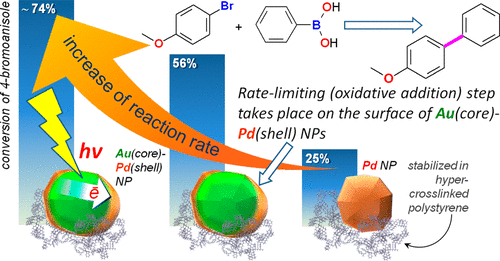当前位置:
X-MOL 学术
›
Org. Process Res. Dev.
›
论文详情
Our official English website, www.x-mol.net, welcomes your feedback! (Note: you will need to create a separate account there.)
Au Core–Pd Shell Bimetallic Nanoparticles Immobilized within Hyper-Cross-Linked Polystyrene for Mechanistic Study of Suzuki Cross-Coupling: Homogeneous or Heterogeneous Catalysis?
Organic Process Research & Development ( IF 3.4 ) Pub Date : 2018-11-14 00:00:00 , DOI: 10.1021/acs.oprd.8b00272 Nadezhda A. Nemygina 1, 2 , Linda Zh. Nikoshvili 1 , Irina Yu. Tiamina 1 , Alexey V. Bykov 1 , Ilia S. Smirnov 1, 3 , Thomas LaGrange 4 , Zbigniew Kaszkur 3 , Valentina G. Matveeva 1 , Esther M. Sulman 1 , Lioubov Kiwi-Minsker 2, 4
Organic Process Research & Development ( IF 3.4 ) Pub Date : 2018-11-14 00:00:00 , DOI: 10.1021/acs.oprd.8b00272 Nadezhda A. Nemygina 1, 2 , Linda Zh. Nikoshvili 1 , Irina Yu. Tiamina 1 , Alexey V. Bykov 1 , Ilia S. Smirnov 1, 3 , Thomas LaGrange 4 , Zbigniew Kaszkur 3 , Valentina G. Matveeva 1 , Esther M. Sulman 1 , Lioubov Kiwi-Minsker 2, 4
Affiliation

|
The synthesis of catalytically active bimetallic Au–Pd nanoparticles stabilized in hyper-cross-linked polystyrene (HPS) for Suzuki cross-coupling of 4-bromoanisole (4-BrAn) and phenylboronic acid is presented. The core–shell structure with a thin (less than 1 nm) Pd shell and a Au core was proven by X-ray diffraction and high-angle annular dark-field scanning transmission electron microscopy combined with energy-dispersive X-ray spectroscopy. More than a 2-fold increase in 4-BrAn conversion was found in comparison with monometallic Pd/HPS. Moreover, when the Suzuki reaction was carried out under visible-light irradiation, the product yield further increased by about 1.3 times (from 56.1% up to 73.7%). This effect was assigned to a local surface plasmon resonance arising in the Au core that allowed electron transfer to the extremely thin Pd layer due to intimate contact with gold. The results suggest that the rate-limiting step of the catalytic cycle takes place on the surface of the Pd shell, serving as evidence of the heterogeneous catalysis nature.
中文翻译:

固定在超交联聚苯乙烯内的Au核-Pd壳双金属纳米颗粒用于Suzuki交叉偶联机理的研究:均相还是异相催化?
提出了在超交联聚苯乙烯(HPS)中稳定的具有催化活性的双金属Au-Pd纳米颗粒的合成,用于4-溴苯甲醚(4-BrAn)和苯基硼酸的Suzuki交叉偶联。X射线衍射和高角度环形暗场扫描透射电子显微镜结合能量色散X射线光谱学证明了具有薄(小于1 nm)Pd壳和Au核的核-壳结构。与单金属Pd / HPS相比,发现4-BrAn转化率提高了2倍以上。此外,当在可见光照射下进行Suzuki反应时,产物收率进一步增加了约1.3倍(从56.1%增加到73.7%)。该效应被归因于在Au核中产生的局部表面等离子体激元共振,由于与金的紧密接触,该共振使电子转移到极薄的Pd层。结果表明,催化循环的限速步骤发生在Pd壳的表面,证明了多相催化性质。
更新日期:2018-11-14
中文翻译:

固定在超交联聚苯乙烯内的Au核-Pd壳双金属纳米颗粒用于Suzuki交叉偶联机理的研究:均相还是异相催化?
提出了在超交联聚苯乙烯(HPS)中稳定的具有催化活性的双金属Au-Pd纳米颗粒的合成,用于4-溴苯甲醚(4-BrAn)和苯基硼酸的Suzuki交叉偶联。X射线衍射和高角度环形暗场扫描透射电子显微镜结合能量色散X射线光谱学证明了具有薄(小于1 nm)Pd壳和Au核的核-壳结构。与单金属Pd / HPS相比,发现4-BrAn转化率提高了2倍以上。此外,当在可见光照射下进行Suzuki反应时,产物收率进一步增加了约1.3倍(从56.1%增加到73.7%)。该效应被归因于在Au核中产生的局部表面等离子体激元共振,由于与金的紧密接触,该共振使电子转移到极薄的Pd层。结果表明,催化循环的限速步骤发生在Pd壳的表面,证明了多相催化性质。



























 京公网安备 11010802027423号
京公网安备 11010802027423号